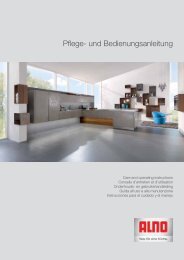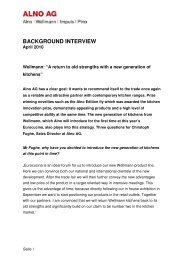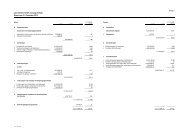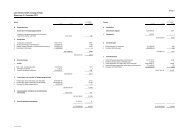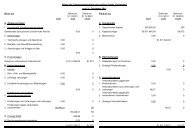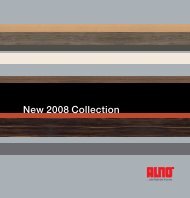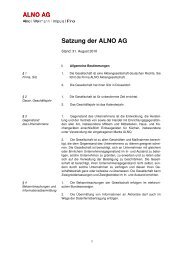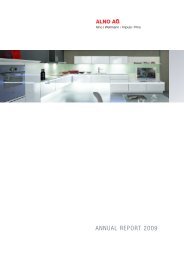The good prospects are based on the all-embracing ... - ALNO AG
The good prospects are based on the all-embracing ... - ALNO AG
The good prospects are based on the all-embracing ... - ALNO AG
Create successful ePaper yourself
Turn your PDF publications into a flip-book with our unique Google optimized e-Paper software.
78<br />
C<strong>on</strong>soLidatEd FinanCiaL statEmEnts | aCCountinG poLiCiEs<br />
Inventories<br />
Raw materials and supplies, as well as <str<strong>on</strong>g>good</str<strong>on</strong>g>s purchased<br />
for resale, <str<strong>on</strong>g>are</str<strong>on</strong>g> always measured at <strong>the</strong> lower of average<br />
cost of acquisiti<strong>on</strong> including incidental acquisiti<strong>on</strong><br />
expenses or net proceeds from sale, as required by IAS 2.<br />
In compliance with IAS 2, work in process and finished<br />
<str<strong>on</strong>g>good</str<strong>on</strong>g>s/services <str<strong>on</strong>g>are</str<strong>on</strong>g> measured at <strong>the</strong> cost of producti<strong>on</strong>,<br />
provided that this does not exceed <strong>the</strong> expected net proceeds<br />
from sale. Producti<strong>on</strong> costs include <strong>all</strong> direct costs<br />
attributable to <strong>the</strong> producti<strong>on</strong> process, as well as a reas<strong>on</strong>able<br />
porti<strong>on</strong> of producti<strong>on</strong>-related overheads.<br />
<str<strong>on</strong>g>The</str<strong>on</strong>g> net revenue value is equal to <strong>the</strong> estimated proceeds<br />
from sale that can be realized in <strong>the</strong> ordinary course of<br />
business, minus <strong>the</strong> estimated costs up to completi<strong>on</strong> and<br />
<strong>the</strong> estimated costs required for distributi<strong>on</strong>.<br />
financial and o<strong>the</strong>r assets<br />
Financial assets essenti<strong>all</strong>y comprise liquid assets, securities<br />
and trade accounts receivable.<br />
<str<strong>on</strong>g>The</str<strong>on</strong>g> opti<strong>on</strong> of classifying financial assets as financial assets<br />
to be measured at fair value through profit or loss when<br />
recognized for <strong>the</strong> first time is not exercised.<br />
In compliance with IAS 39, trade accounts receivable <str<strong>on</strong>g>are</str<strong>on</strong>g><br />
classified as "loans and receivables issued by <strong>the</strong> company"<br />
and recognized at <strong>the</strong> amortized cost of acquisiti<strong>on</strong><br />
using <strong>the</strong> effective interest rate method. Reas<strong>on</strong>able specific<br />
valuati<strong>on</strong> <strong>all</strong>owances equal to <strong>the</strong> difference between<br />
<strong>the</strong> carrying amount of <strong>the</strong> asset and <strong>the</strong> present value of<br />
expected future cash flows <str<strong>on</strong>g>are</str<strong>on</strong>g> made for doubtful accounts<br />
receivable. <str<strong>on</strong>g>The</str<strong>on</strong>g> specific valuati<strong>on</strong> <strong>all</strong>owances <str<strong>on</strong>g>are</str<strong>on</strong>g> recognized<br />
in a value adjustment account. If <strong>the</strong> impairment<br />
decreases in subsequent periods, <strong>the</strong> valuati<strong>on</strong> <strong>all</strong>owance<br />
is reversed, provided that <strong>the</strong> carrying amount does not<br />
exceed <strong>the</strong> amortized cost of acquisiti<strong>on</strong> following reversal.<br />
Impairment losses and <strong>the</strong>ir reversals <str<strong>on</strong>g>are</str<strong>on</strong>g> recognized as<br />
income in <strong>the</strong> c<strong>on</strong>solidated income statement. Accounts<br />
receivable <str<strong>on</strong>g>are</str<strong>on</strong>g> derecognized when <strong>the</strong>ir irrecoverability is<br />
established.<br />
Securities and interests held in associated companies <str<strong>on</strong>g>are</str<strong>on</strong>g><br />
classified as "available-for-sale financial assets". After firsttime<br />
recogniti<strong>on</strong>, <strong>the</strong>y <str<strong>on</strong>g>are</str<strong>on</strong>g> always measured at fair value.<br />
In <strong>the</strong> case of securities, this is equal to <strong>the</strong> current price.<br />
Gains and losses from changes in fair value <str<strong>on</strong>g>are</str<strong>on</strong>g> recognized<br />
outside profit or loss in equity until <strong>the</strong> financial asset is<br />
disposed of or until an impairment loss is established. In<br />
<strong>the</strong> event of an impairment loss, <strong>the</strong> accumulated net loss<br />
is removed from equity and expensed.<br />
Interests held in associated companies <str<strong>on</strong>g>are</str<strong>on</strong>g> measured at<br />
acquisiti<strong>on</strong> cost, as <strong>the</strong>re is no active market and <strong>the</strong> fair<br />
values cannot be reliably determined due to <strong>the</strong> absence<br />
of corporate planning. Indicated impairment losses <str<strong>on</strong>g>are</str<strong>on</strong>g><br />
recognized through profit or loss.<br />
First-time recogniti<strong>on</strong> of financial assets is always posted<br />
<strong>on</strong> <strong>the</strong> settlement date.<br />
A financial asset is derecognized when <strong>the</strong> c<strong>on</strong>tractual<br />
right to cash inflows from <strong>the</strong> asset is satisfied, expires<br />
or <strong>all</strong> risks and rewards have essenti<strong>all</strong>y been transferred.<br />
Derecogniti<strong>on</strong> is also posted <strong>on</strong> <strong>the</strong> settlement date.<br />
Financial assets <str<strong>on</strong>g>are</str<strong>on</strong>g> also derecognized if <strong>the</strong> essential risks<br />
and rewards associated with ownership <str<strong>on</strong>g>are</str<strong>on</strong>g> nei<strong>the</strong>r transferred<br />
to <strong>the</strong> acquirer nor retained as a result of transferring<br />
financial assets, and <strong>the</strong> power to dispose of <strong>the</strong> financial<br />
assets passes to <strong>the</strong> acquirer. <str<strong>on</strong>g>The</str<strong>on</strong>g> rights and duties arising<br />
or remaining after such transfer <str<strong>on</strong>g>are</str<strong>on</strong>g> recognized separately<br />
as an asset or liability. However, if <strong>the</strong> power to dispose<br />
of <strong>the</strong> transferred financial assets remains with <strong>the</strong> <strong>ALNO</strong><br />
Group, <strong>the</strong> sold assets <str<strong>on</strong>g>are</str<strong>on</strong>g> still recognized in <strong>the</strong> amount<br />
of <strong>the</strong> c<strong>on</strong>tinuing commitment. An associated liability is<br />
simultaneously posted under o<strong>the</strong>r liabilities. Differences<br />
between <strong>the</strong> assets and liabilities posted <str<strong>on</strong>g>are</str<strong>on</strong>g> recognized<br />
in <strong>the</strong> financial result.<br />
O<strong>the</strong>r assets <str<strong>on</strong>g>are</str<strong>on</strong>g> recognized at acquisiti<strong>on</strong> cost, liquid<br />
assets at <strong>the</strong>ir nominal value.




